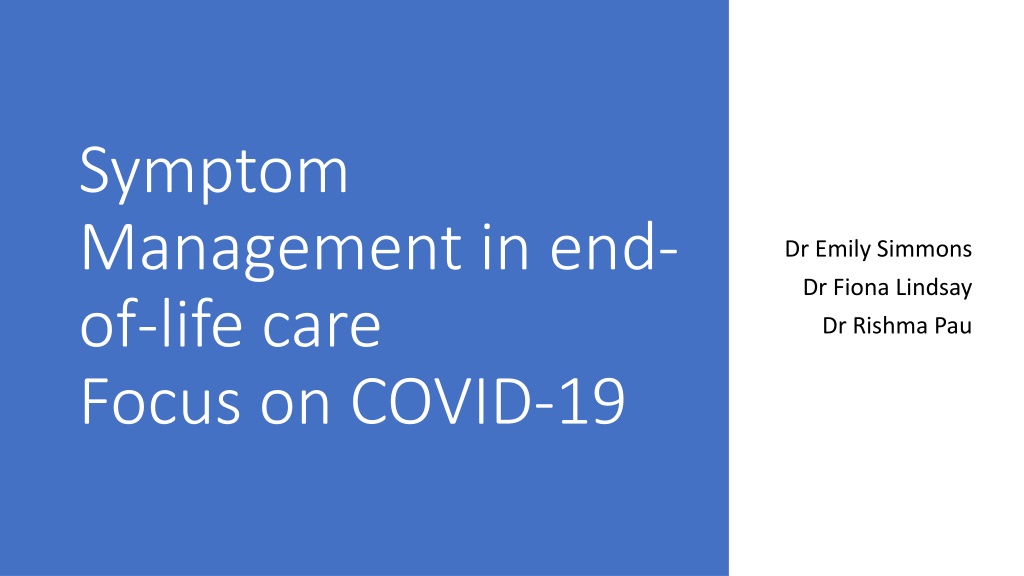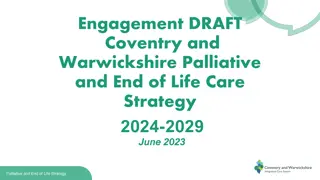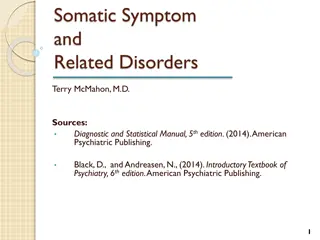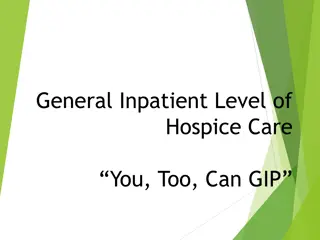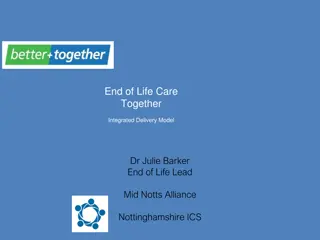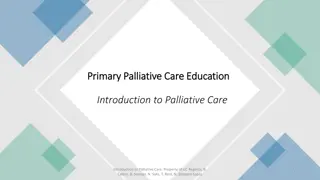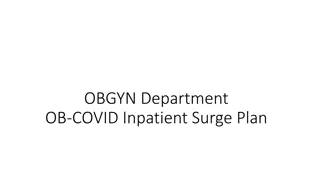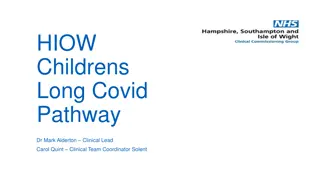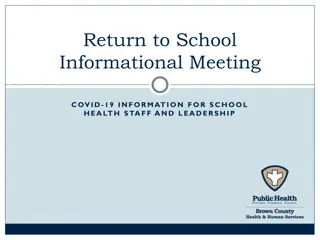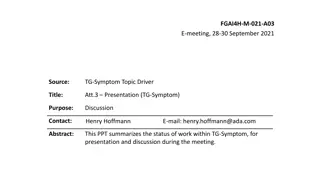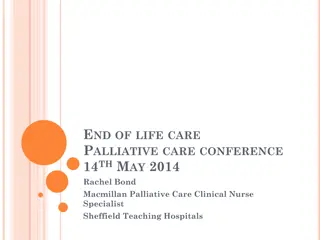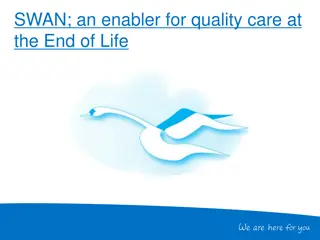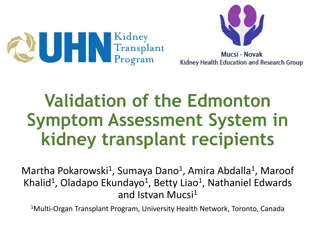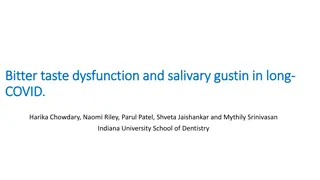Symptom Management in End-of-Life Care: Focus on COVID-19
Review signs of dying, communicate effectively with residents and families, identify end-of-life symptoms (especially related to COVID-19), and explore non-pharmacological and pharmacological approaches for symptom management. Resources and guidance are provided for caring for individuals in the community or at home during the COVID-19 pandemic.
Download Presentation

Please find below an Image/Link to download the presentation.
The content on the website is provided AS IS for your information and personal use only. It may not be sold, licensed, or shared on other websites without obtaining consent from the author.If you encounter any issues during the download, it is possible that the publisher has removed the file from their server.
You are allowed to download the files provided on this website for personal or commercial use, subject to the condition that they are used lawfully. All files are the property of their respective owners.
The content on the website is provided AS IS for your information and personal use only. It may not be sold, licensed, or shared on other websites without obtaining consent from the author.
E N D
Presentation Transcript
Symptom Management in end- of-life care Focus on COVID-19 Dr Emily Simmons Dr Fiona Lindsay Dr Rishma Pau
Review signs that may identify a resident is dying Communication to resident and their family/carers Recognise symptoms of end of life and in particular COVID-19 Review non-pharmacological and pharmacological approaches to common symptom management in COVID 19 Learning Objectives
The Martlets Hub 01273 The Residents GP District Nursing Team Community Palliative, End of Life and Bereavement Care in the COVID- 19 pandemic: A guide to End of Life Care symptom control when a person is dying from COVID19. RCGP and APM, March2020 www.elearning.rcgp.org.uk British Geriatrics Society: Fact Sheet: COVID-19: End of life care in older people. April 2020 https://www.bgs.org.uk/resources/covid-19-end-of- life-care-in-older-people Guidance for GPs for symptom control of palliative patients in the community during the Coronavirus Pandemic. Sussex CCG March 2020 http://www.sussexccgs.nhs.uk/wp-content/uploads/2020/04/11.-One- page-Summary-of-Palliative-pharmacological-options.-Local-Guidance- v3.pdf Caring for your dying relative at home with COVID 19, Hospice UK, April 2020. https://www.hospiceuk.org/what-we-offer/clinical-and-care- support/what-to-expect/caring-for-your-dying-relative-at-home-with- covid-19 List of Carer Specific Resources on the last slide provided by Hospice UK Resources to use
Most people will have mild to moderate disease (80%), but some will have more serious symptoms with uncertain recovery due to their underlying illnesses and frailty 15% require hospital admission for severe disease Some residents may not want to go to hospital and would prefer to be cared for in their home environment by familiar staff (as per ACP discussions) Hospitals may reach capacity and triage decisions may require care in the community 5% become critically ill requiring ICU, however most residents will want or benefit from ICU treatments Severity of underlying health conditions or frailty (as highlighted in ACP discussion between patient, yourselves and primary/palliative care team) ICU admission is determined by secondary care providers Symptom and end of life care in hospital or community (as per ACP discussions). Management of Symptoms
Hopefully ACP have or are being reviewed ReSPECT webinar Honest conversation about preferred place of care, goals of care, treatment escalation plans initiate early, involve families and carers COVID-19 patients become ill and deteriorate quickly, opportunities for discussion at the time may be limited or lost Discussions about care plans
Work with GP, District Nursing and Palliative Care Teams Management of common symptoms, during deterioration and dying Correct the correctable Optimising treatment of other illnesses such as COPD or Heart Failure may improve cough and breathlessness In discussion with GP, antibiotics treatment for a secondary bacterial infection may improve symptoms of fever, cough, breathlessness and delirium (before the dying phase if patient can swallow) Non drug and drug approaches Approach to symptom management
Shivering Shaking Chills Aching muscles and joints Other body aches Fever Fever
Fever Management Drug (Pharmacological) Approach Paracetamol 500mg to 1 gram orally up to 4 times a day Liquid or can crush tablets in small amount of soft food e.g. ice cream It is not advised to use NSAIDS in those who may recover from COVID for fever management Ibuprofen/nurofen/diclofenac etc Non-Drug Approaches Reduce room temperature Wear loose clothes Cool face by using cold flannel or cloth Oral fluids Fans are not recommended
Cough Management Non-Drug Oral fluids Honey & Lemon in warm water Cough drops/sweets Elevate head Avoid smoking Humid air if possible Drug (Pharmacological) Treat possible causes: Bacterial infection Asthma/COPD/HF Simple linctus 5-10mg orally QDS Codeine linctus 30-60mg PO QDS Morphine sulphate Immediate release 2.5mg PO 4 hourly Seek specialist advice E.g. diamorphine 2.5mg SC prn or csci Hygiene to minimise cross transmission Catch it, bin it, kill it Cover nose and mouth with tissue Dispose of used tissue promptly Clean hands
Due to existing co-morbidities From excessive coughing or immobility Use existing approaches where in place Pain ladder for mild pain and the patient doesn t take regular painkillers Suggested starting doses of strong opioids where pain is more severe GP to prescribe PAIN Discuss with GP/Specialist Team if starting doses are not effective or patient already uses higher doses of strong opioids Needing more than 3 extra doses a day Total daily dose of oral morphine is over 120mg Concerns about side effects Strategies for patients who can t swallow If pain stable then patches may work if patient hasn t got temperature/sweating Specialist advise to start SC doses
Strong Opioids Starting Dose opioid-na ve/frail/elderly morphine 2.5-5mg PO IR 4 hourly previously using regular weak opioid (e.g. codeine 240mg/24h) morphine 5mg PO IR 4 hourly or MR 20-30mg BD frail/elderly: use lower starting dose of 2.5mg PO IR 4 hourly or MR 10-15mg BD eGFR <30 seek advice Mild Pain Mild Pain Step 1 - Regular Paracetamol 1g QDS Step 2 - Codeine 30-60mg QDS Step 3 - Paracetamol and Codeine Step 4 - Stop codeine and start strong opioid Continue the paracetamol in each step if helpful
Sensation of discomfort with breathing Major suffering in acute, advanced and terminal disease, distressing for patient, family and carers Assess breathlessness to communicate to wider healthcare team: Consider respiratory rate, observe breathing Is there evidence of cyanosis (blue lips) Can they finish a sentence? Remember the correctable causes Asthma/COPD/Heart Failure Bacterial infection - Antibiotics Support residents in non-drug approaches (Webinar on Breathlessness) Drug (Pharmacological) approaches may need to be stepped up quickly if a patient is deteriorating rapidly, seek GP and Specialist support early Breathlessness
Breathlessness Drugs (Pharmacological) Non-Drug - Positioning see cartoon - Relaxation techniques - Distraction - Psychological support - mindfulness - Reduce room temperature (open window) - Cool face with cloth - No fans - Opioids (reduce perception) - Oramorph 1mg hourly until breathing under control may cause drowsiness - OR 2.5-5mg prn 4 hourly - Anti anxiety - Lorazepam 0.5mg SL prn - If patient can t swallow - Morphine 1.25-2.5mg prn sc - Midazolam 2.5-5mg prn sc - SC doses take at least 20 minutes to work so wait to see effect
Delirium is sudden onset of confusion when someone is ill Usual behaviour changes and they could become more agitated or feel more sleepy/withdrawn Identify and treat underlying causes where possible Breathlessness or Pain Superadded infection Drugs Dehydration Constipation or Urinary retention Agitation is commonly seen in the dying patient, see Webinar on Terminal Agitation for a more detailed approach Non-drug and drug (pharmacological) approaches: seek advice of GP/Palliative team early if not working Delirium and Agitation
Non-Drug Drug (Pharmacological) Mild/Mod/Severe Haloperidol 0.5mg either PO/SC or 24/hour csci, 0.5mg prn all routes BSG advise caution in giving >2mg/24 hour in elderly Severe distress can give higher starting dose (1.5- 3mg PO/SC) Add Benzodiazepine if remains agitated Lorazepam 0.5mg SL prn Midazolam 2.5-5mg SC prn Drug (Pharmacological) Terminal Agitation Levomepromazine SC 6.25-12.5mg prn hourly if needed Could give higher doses BD or start syringe driver Use prn on top Midazolam SC 2.5-5mg SC prn hourly if needed Maintain higher dose in syringe driver if needed Rule out correctible causes Communicate and orientate Provide reassurance Involve family/carers if possible Keep surroundings familiar Consider lighting
Other Symptoms Nausea and Vomiting Haloperidol 0.5mg PO/SC Can be added to syringe driver Respiratory Secretions Respiratory Secretions No oral preparations available Hyoscine patch could be prescribed if needed to avoid SC Glycopyrronium 400micrograms SC hourly (max 1.2mg/24 hour) Dry Mouth and Thirst Give a few teaspoon at a time, propped up of any drink they want Mouth care Don t worry about food yoghurt, ice cream, jelly etc may be helpful
